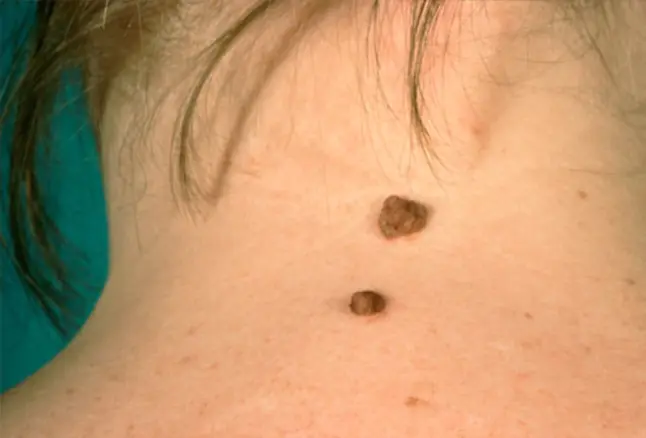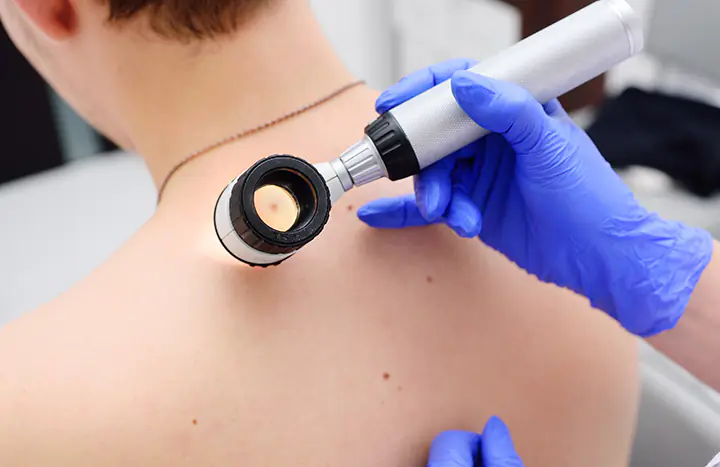You can find many birthmarks on every person’s body. Some have been present since childhood, some appear throughout life. They are not dangerous in themselves, but many dermatologists strongly recommend periodically monitoring the condition of moles on the body. A cause for concern may be a change in the color of the birthmark or its enlargement. However, if it happens that a mole falls off on its own or as a result of mechanical damage, then this is a serious reason to seek advice from a doctor. Let's figure out what such precautions may be associated with.
What are moles?
Birthmarks are usually called some congenital or acquired skin defects that are formed as a result of a certain proliferation of the epithelium of the skin containing the melanin pigment. Congenital moles can appear in a person several months after birth. Acquired ones arise at different periods of life, manifesting themselves especially intensely during certain hormonal changes. Moles are considered benign formations that, in most cases, are not prone to the development of oncological processes. However, dermatologists strongly recommend monitoring their changes.
But no need to worry. Statistics show that skin cancer develops from areas of the skin that do not contain birthmarks in eighty percent of cases, and only twenty percent develops from them.
Nevertheless, a very serious reason to visit a medical institution for the purpose of consultation is the situation when a mole has fallen off. This is not always evidence of skin diseases. However, it is better to play it safe, undergo appropriate diagnostics and identify the causes of this circumstance.
It is worth remembering that skin cancer diagnosed in time can be successfully cured without leaving any health consequences. Advanced cases are difficult to treat and even lead to death.
Reasons for spontaneous loss
Many people wonder whether a mole can fall off on its own. Maybe due to certain external or internal factors. So, for example, it happens that a hanging mole, located in an inconvenient place, falls off due to mechanical damage.
In addition, there are many more reasons. So, the consequences that led to the mole falling off may be the following:
- Mechanical damage due to scratching, wearing scratchy jewelry, shaving, etc.
- Presence of skin cancer. As a rule, in such cases, the birthmark disappears due to a certain mutation process in this area of the skin
- Problems with blood circulation. Nutrition does not reach the skin and the mole falls off on its own.
Reasons for falling off of a hanging mole
A birthmark that rises greatly above the skin is often injured and falls off. However, a mole may fall off on its own under the influence of various hormonal disorders in the body or also due to the development of an oncological tumor. At the same time, it may just be a harmless old papilloma, resembling a birthmark in appearance. Hanging moles are considered the most dangerous, since malignant formations predominantly develop from them. Therefore, doctors examine them most carefully. If you notice any changes occurring with this type of birthmark, you should immediately consult a doctor.

Dangerous symptoms
If you notice that a mole is drying up and falling off, this is a serious reason to consult a doctor. As a rule, such a symptom indicates the beginning of the transformation of a birthmark into an oncological neoplasm. Symptoms accompanying the fact that a mole has dried out and fallen off may include itching, burning, and there may also be some discomfort or even pain.
Also symptoms that indicate that you need to see a doctor immediately are bleeding of the birthmark, peeling, change in shape and size.
After removal
If you have undergone laser removal of a birthmark in a special medical institution, then a crust will form in its place as a normal process, indicating healing of the skin. Do not worry if after a certain time the crust falls off after removing the mole on your own.

You shouldn't rip it off with your own hands. After all, an unhealed wound can become infected or cause the formation of a scar. If the crust falls off after removing the mole too early, exposing an unhealed layer of skin, then do not worry. You need to treat the wound with antiseptic agents and do not touch it with dirty hands.
Diagnostics
If you begin to notice changes happening to your birthmark, it is better to consult a specialist. There are two areas of medicine that deal with this problem - oncology and dermatology. You can contact doctors in these areas for advice.
As a rule, the main method for diagnosing a birthmark that has fallen off is histology. A tissue sample of the mole is submitted for analysis, where through various machinations it is determined whether it is a malignant formation.
Another diagnostic method often used in practice is dermatoscopy. With this method of analysis, using a special device, the area of skin with a problematic birthmark is enlarged and carefully examined for pathological changes.

Also, several diagnostic methods are often used to obtain a more reliable result.
Treatment
A mole has fallen off, what should I do? First of all, you shouldn’t panic, but it’s also undesirable to let everything take its course. The first thing to do is make an appointment with an oncologist or dermatologist. After diagnosis, there are two options for the development of events.
In the first case, if the birthmark turns out to be a malignant formation, an operation is required to remove the affected layers of skin.
If the mole is safe, then it is worth taking certain measures to heal it. As a rule, the doctor himself prescribes special healing and disinfecting preparations.

Prevention
The most reliable and best prevention to ensure that a birthmark does not bring any unpleasant and serious consequences is the attentiveness of the person himself to its various modifications.
If you notice any strange symptoms such as flaking, itching, redness and bleeding, then do not be afraid to consult a doctor. Another reason for contacting a specialist is an increase in the size of the birthmark and a change in its color.
The appearance of a large number of moles is a suspicious symptom that requires consultation with a specialist. You should also be wary if a mole falls off on its own or begins to fall off in parts. It is important to remember that a malignant tumor diagnosed in time is successfully treated without any consequences in ninety-five percent of cases.
Also of no small importance in the prevention of malignant formations of birthmarks is careful skin care in the summer. Ultraviolet radiation activity can cause serious problems. It is recommended not only before tanning, but also simply before leaving the house on a sunny day, to apply a special sunscreen to the skin.

It is also recommended to remove birthmarks in places where there is a risk of mechanical damage. As a rule, this is the neck area, where people often wear various kinds of chains, the armpit area, and for men it can also be the area of shaving on the face.
Risk factors
It is very difficult to determine when a fallen-off mole is a malignant formation. However, there are certain risk factors, falling into the category of which a person should be more attentive to the condition of his skin and birthmarks in particular.

So, the possibility of a malignant formation developing from a birthmark is influenced by the following set of factors:
- Patient's gender. As a rule, women are less susceptible to this problem. Most often, this type of cancer is found in men.
- Location. Birthmarks that are localized in the arm area most likely will not be hazardous to health.
- Type of birthmark. Hanging moles in this regard are more dangerous than ordinary ones. Experts pay careful attention to them.
It is also worth noting that people with white skin, the presence of a large number of birthmarks and apical rashes are prone to this pathology. Also, the development of this kind of disease is influenced by genetic predisposition, that is, the presence of relatives with a similar problem, and old age.
However, do not panic if a mole falls off or if any other changes occur to it. You just need to see a doctor. And even if the diagnosis is disappointing, malignant formations on the skin can be easily treated using modern medical techniques.
The mole itself, as some sources explain, is an accumulation of melanocyte cells, which form its color.
Doctors' opinions on the most effective methods of treating warts and papillomas
The chief physician of Moscow City Hospital No. 62 describes his vision on this matter. Anatoly Nakhimovich Makhson
Medical practice: more than 40 years.
“I have been treating people’s papillomas and warts for many years. I’m telling you as a doctor, papillomas along with HPV and warts can really lead to serious consequences if they are not dealt with.
The human papillomavirus is present in everyone on whose body there are papillomas, moles, warts and other pigmented formations. According to rough estimates, 80-85% of the planet's population has it. By themselves they are not dangerous. The problem is that an ordinary papilloma can become melanoma at any time.
These are incurable malignant tumors that kill a person in just a few months and from which there is no salvation.
Unfortunately, in Russia and the CIS countries, pharmaceutical corporations sell expensive medications that only relieve symptoms, thereby hooking people on one drug or another. That is why in these countries there is such a high percentage of cancer diseases and so many people suffer from “non-working” drugs.
The only drug that I want to recommend, and it is also officially recommended by WHO for the treatment of papillomas and warts, is Papinol. This drug is the only remedy that has an effect not only on external factors (that is, it removes papillomas), but also acts on the virus itself. At the moment, the manufacturer has managed not only to create a highly effective product, but also to make it accessible to everyone. In addition, within the framework of the federal program, every resident of the Russian Federation and the CIS can receive it for 149 rubles.”
To find out more, read this article.
Moles are present on every person's body; they do not pose any particular danger. Some call them age spots, some call them neoplasms. Sometimes we observe that a mole has fallen off, changed in size, and in other cases it exists until the person’s death, without interfering with his daily life. This article will help answer questions that concern many: what to do when a mole falls off without blood or with consequences? Why do moles fall off? Can such a phenomenon pose a threat to human health and even life?
Consequences of a fallen mole
If a hanging mole (papilloma) falls off, this indicates a change in the hormonal cycle in the body, which affects the fall of the formation on the skin. Sometimes a mole may fall off due to natural positive regression in the body.
What first aid should be provided if a mole falls off:
- Stop the bleeding;
- Treat the wound;
- Moisten a cotton swab with hydrogen peroxide, close the wound with it, stick a medical plaster on top and consult a dermatologist and surgeon as soon as possible;
- If it is possible, the fallen part of the mole should be placed in saline solution for preservation; this will be needed to examine it for cancer. But if there are no remnants of the mole, the doctor will take the necessary tissue from the wound. Next, the doctor will examine the wound with a dermatoscope for the presence of pathologies, such as itching, redness, peeling, and the presence of fluid in the wound.
An examination of the mole or the place where it was located can be performed using ultrasound and after obtaining tissue analyzes of the injured mole, the doctor will be able to prescribe treatment.
In some cases, the mole may shrink in size on its own and fall off. A mole that has matured, dried for a long time and then fallen off is considered not dangerous. It’s worse when a mole falls off suddenly and in a short period of time, then you need to urgently consult a doctor.
Treatment of moles is accompanied by laser therapy or surgery.
Some people believe that if a mole falls off and a wound remains, it will heal on its own. You should not be careless, as any benign mole can degenerate into a malignant one. In addition, mole cells and roots may remain inside the skin, and if you do not seek the advice of a specialist in time, you can spread the infection through the wound into the blood.
The most reliable way to get quality treatment if a mole falls off is to submit pieces of the mole for histology.
Important! Under no circumstances should you remove or somehow get rid of a mole yourself. Any unprofessional intervention can affect the degeneration of a mole (nevus) into a malignant tumor.
be careful
The presence of papillomas, warts, condylomas, moles and spines on the body is the first sign of malignant melanoma!
We hasten to warn you that most medications “treat” warts, papillomas, moles, etc. - this is a complete deception of marketers who make hundreds of percentage points on drugs whose effectiveness is zero. They do not cure the disease, but only mask the symptoms.
The pharmacy mafia makes huge money by deceiving sick people.
But what to do? How to treat if there is deception everywhere? Doctor of Medical Sciences Anatoly Makhson conducted his own investigation and found a way out of this situation. In this article, the Doctor also told how to 100% protect yourself from melanoma, for only 149 rubles!
Read the article in the official source following the link.
The mole has dried up and fallen off
The mole noticeably dries before our eyes, changes in color and size, all this indicates the initial stage that the mole will soon fall off. The color of a mole may change along its borders, within the mole itself. Sometimes a mole may turn black or, on the contrary, become lighter. Such characteristics should alert you and prompt you to contact a dermatologist-oncologist. The size of the mole may increase both in width and height, in volume, and become irregular in shape.
If you notice such transformations in yourself, it is important to get examined. A change in the shape of a mole and color may indicate malignant degeneration - malignancy, which in turn can lead to the formation of the most dangerous tumor - melanoma. Such a degenerated mole metastasizes through important vital systems of the body - circulatory and lymphatic. The oncologist surgeon determines the process of degeneration of the mole, in which cases treatment is necessary, and also in what direction the cells of the mole have changed into malignant and benign tumors. But it is worth noting that the malignant degeneration of a mole is melanoma. The remaining processes of change are benign.
The number of moles throughout our lives also changes. The body is aging, which means that biological processes and blood circulation are slowing down. The mole receives less nutrition and this may cause it to dry out and fall off.
What to do if your mole has dried up and fallen off, become crusty, itchy, itchy? A test for the presence of melanin should be carried out immediately to prevent danger. Under no circumstances should you throw away any pieces that have fallen off; they should be collected and submitted to a doctor for analysis.
Attention! If your mole becomes inflamed or begins to hurt, you should immediately contact a specialist!
Pieces fall off the mole
As a result of observations, it turned out that a mole can fall off for a variety of reasons. The nevus can be damaged mechanically, with a razor, metal objects on clothing, or a washcloth, and then its integrity is compromised, which leads to it falling off piece by piece.
If you notice that your dry mole has completely fallen off or part of it has fallen off, but you do not find any consequences on your body, then this may indicate that you are overly carried away by taking ultraviolet rays.
With malignant transformations, the mole will crumble and fall apart into pieces. Such changes will be accompanied by redness, peeling, and itching in the area of decay. To find out the cause of this pathology, pieces of the mole should be analyzed in the oncology department.
We also recommend that you watch the video, which describes in detail the consequences of damage to a mole and its removal:
If a mole spontaneously dries out, crumbles, quickly darkens or falls off, this may be a sign of the development of a deadly disease - melanoma, which can kill a person within two to three months.
Reasons why moles fall off
The most common factors contributing to damage to the nevus and its spontaneous disappearance are: physical impact as a result of constant friction, damage from sharp objects, or impact. However, this also happens for more serious reasons:
- circulatory disorders. If the formation experiences a nutritional deficiency, it may gradually dry out and fall off;
- benign degeneration. In this case, the pigment composition of the mole cells changes. The condition is not life-threatening or health-threatening;
- malignant degeneration. The rarest, but also the most unfavorable option. Irreversible processes of destruction occur inside a nevus with an altered cellular structure. In some cases, this lasts for years, in others, a couple of months is enough for the tumor to metastasize.

Photo 1. Accidental injury to a mole can trigger the development of cancer. Source: Flickr (kenga86 Korneeva).
If the formation occurred against the background of a hormonal imbalance, and after a while the problem was eliminated, the mole may fall off on its own. But it is necessary, with the help of a specialist, to make sure that the cause of the fallen nevus is the stabilization of the endocrine system. In all other cases a fallen off nevus is a reason for urgent consultation with an oncologist.
Symptoms
Rejection of a skin lesion is usually preceded by certain symptoms.
| Symptoms | Possible reasons |
|---|---|
| blackening, especially of an old mole | changes in hormonal levels, excessive exposure to ultraviolet radiation, malignant degeneration |
| drying, peeling, itching, pain | nevus nutritional deficiency, frequent rubbing against clothing, development of melanoma |
| crumbling, when pieces fall off from the mole | microtraumas resulting from friction, cuts, excessive tanning; degeneration into a malignant form |
| reduction in size of formation | natural regression process, lack of blood flow, dangerous structural changes |
| enlargement and color change, accompanied by itching, pain, blurry, asymmetrical shape | nevus malignancy |
These symptoms and causes are characteristic of both flat and hanging nevi.
Note! A mole can easily be confused with a papilloma, especially an old one. The latter sometimes disappears on its own due to strengthening of the immune system.
Diagnostics
Regardless of whether the entire mole has fallen off or just part of it, it is necessary to collect the remainder of your education and immediately pass it on histological analysis, which is guaranteed to establish the nature of the nevus.
Diagnostics includes:
- comprehensive examination of the body's condition, including instrumental and laboratory procedures;
- dermatoscopy — method of visual diagnosis of the dermis;
- biopsy skin tissue, which helps to promptly detect malignant degeneration;
- histological analysis — the most accurate and effective method of tissue research;
- mapping moles, especially useful if their number exceeds 50 pieces.
Each of these methods can be used separately, however, the combination of several types of research provides a more complete and reliable picture.

Photo 2. The detached mole must be taken to the clinic for examination. Source: Flickr (Joel Schlessinger)
What to do if a mole is rejected
Even if a dried nevus has fallen off and no traces remain in its place, it is necessary to visit an oncodermatologist for testing.
But first you need disinfect the wound and stop the bleedingto avoid complications: infection and bleeding.
- Take a sterile bandage, soak it in hydrogen peroxide, apply it to the wound and hold it until the bleeding stops.
- Repeat the procedure using chlorhexidine, apply a napkin with it for 5 minutes.
- Cover the wound with a bactericidal bandage and consult a doctor.
If the formation has not completely fallen off or is simply damaged, do the same.
It is important! Under no circumstances should you tear off a torn mole yourself - this is life-threatening!
The one that fell off wrap the mole in a sterile napkin soaked in pharmaceutical saline solution. You can use it instead weak solution of table salt (1 tsp per 1 liter of boiling water) or mineral water. In this form, the nevus must be taken to the hospital for examination.
Signs of complications
- spontaneous, long-term bleeding;
- inflammation places of a fallen mole;
- strong itching;
- purulent discharge from the wound;
- temperature increase bodies.
These symptoms indicate infection of the dermis; the condition requires immediate medical intervention, the prescription of antibiotics and other drugs.
Attempts to independently cope with the treatment of a fallen mole lead, at best, to the formation of scars, and at worst, if the nevus cells are not completely rejected, to the development of skin cancer.
Treatment
The method of treating a damaged nevus is selected by the doctor based on research results. A benign lesion usually does not require treatment, with the exception of wound care. It consists of careful treatment with antiseptics, and later in the use of wound-healing external agents.
If the mole was malignant, the specialist may recommend surgery, the purpose of which is to remove remaining pathological cells.
For this we use:
- laser. The least traumatic and safe method that can be used on any part of the body, including the face and mucous membranes;
- cryodestruction. Liquid nitrogen or carbonic acid ice is used to destroy nevus cells. Suitable only for small flat formations;
- electrocoagulation. Burning with an electric knife is indicated for removing blackened moles. Not suitable for large nevus size;
- radio wave method. An effective, low-traumatic, but not very common method:
- surgical scalpel. Allows you to completely remove all pathological cells. The method is suitable in all cases, however, it has a significant drawback: a high risk of scar formation.
In addition, malignant tumors at the initial stage require prescription immunomodulating drugs based on interferon. They are able to prevent the growth of diseased cells and stop metastasis. Additionally, anti-inflammatory and antitoxic drugs and herbal medicine are used.
Note! If a mole has turned black, dried out, or fallen off, this cannot be the norm! No self-medication, traditional medicine or other amateur activities! Only disinfection and immediate medical attention!



